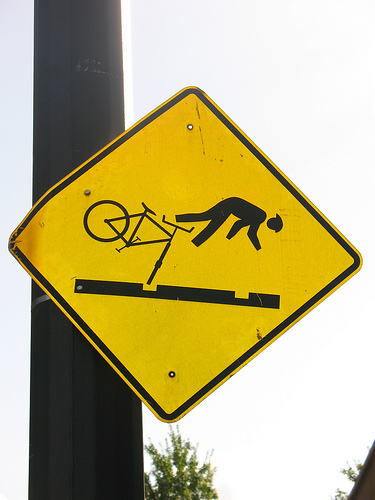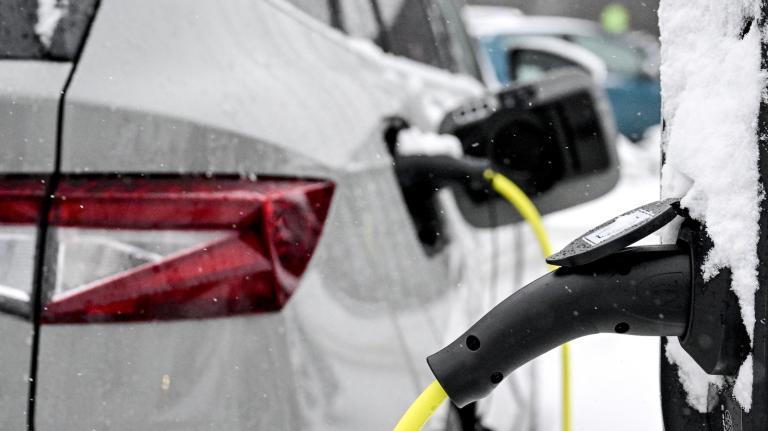 Some bike crashes are easy to prevent.Photo: Mark StosbergOne dark night last summer, my front tire caught a rut in a bumpy back street.
Some bike crashes are easy to prevent.Photo: Mark StosbergOne dark night last summer, my front tire caught a rut in a bumpy back street.
I went flying and landed on my hands and helmet. My bike flipped in the air and fell on top of me. I sat there in the road for several minutes taking inventory. Scraped hands. Bent glasses. Going to need some new bar tape, but everything else in one piece. I walked the last two blocks to my house and went to bed. The next morning I yanked my brake lever back into position and rode off to go get my glasses fixed, eat a big breakfast, and put in a half day at work. I was shaky, but not too much worse for the wear.
This was my only crash in five years of riding my bike in Portland for miles every day. Which is predictably average, according to the results of a new study that sought to track and understand bicycle-related injuries. (You can read and download the study directly here.)
A team of researchers at the Oregon Health & Science University (OHSU) followed 962 regular bicycle commuters in Portland for a year, checking in with them monthly. During that year, they found, 20 percent of riders suffered some kind of crash. Most of these crashes (they call them “traumatic events”) were, like mine, minor. A quarter of the crashes (or 5 percent) required medical attention. Going by these numbers, a regular bike commuter in Portland can expect to crash his or her bike once every four years, with three out of four of those crashes being relatively minor.
There’s a lot of talk out there in the bicycling community about how safe bicycling is or isn’t. Everyone has a take, from safety-conscious advocates who focus on helmet use to relentlessly positive bike evangelists who fear that any hint of safety talk will hurt the emerging golden brand of bike culture.
When it comes to hard data, though, we don’t have a whole lot. And what’s out there isn’t always encouraging.
According to the Federal Highway Administration, last year there was about one fatality and 74 injuries among motor vehicle occupants for every 100 million miles driven. The numbers for the OHSU study subjects, on the other hand, were 1,500 crashes of any type and 390 needing medical attention per 100 million commute miles. (No fatalities occurred among the study subjects, though there was one bicycle commute-related fatality in Portland during its duration.)
The metrics don’t align perfectly, but they would indicate that the chance of sustaining an injury more serious than scrapes and bruises in a bike crash is about five times the risk of injury in a car crash. Other studies have shown that externalities like the health benefits of active transportation reverse that equation many times over. But these numbers are worth looking at and taking seriously nonetheless.
Looking for solutions, the OHSU team focused on the 20 percent of crashes — serious and otherwise — that involved poor roadway design and maintenance and that could be easily corrected. The most notable causes of this type of crash were gravel on the roadway, metal plates on the road in construction zones, and rail tracks, particularly ones that people on bikes need to cross when making left or right turns. Fixing these issues would presumably make bicycle commuters a mere four times more likely to be injured than drivers.
So if 20 percent of these injuries could be eliminated by simple, cost-effective measures, we should implement them immediately. Road maintenance crews need to route bike traffic around metal plates. Street sweepers cleaning up gravel after a snowstorm should prioritize bike routes. And with all the sharp people behind the new streetcar renaissance, surely something can be done about that inconvenient but undeniable conflict between rail tracks and bike tires?
Of course, it isn’t that easy. Issues like gravel removal and potholes are politically loaded. But tackling them is nothing compared to the challenge of addressing the 48 percent of more serious crashes in the OHSU study that involved motor vehicles.
Take cars out of the picture, or at least move them far enough away from bikes, and the armored/non-armored traffic safety equation would be reduced to only one to three, again not including those all-important externalities.
The researchers didn’t suggest solutions for this type of crash, and it’s no wonder. Cars are such a powerful industry and such a normalized part of our daily lives that even acknowledging the hazards a vehicle presents to anyone other than its occupants is essentially taboo.
The OHSU study is notable because it didn’t just capture more serious crashes, but also minor spills like the one I took. The damage I sustained was mostly intangible. The worst of it was the fear I felt riding my bike for several weeks afterwards. Feelings like that don’t matter to the agencies doing most of the counting — the DMV, the police, insurance companies. But feelings matter a lot to people who ride. And, perhaps more significantly, to those who don’t yet.
Bicycling is safe and healthy, as modern transportation goes. But as the OHSU numbers show, we could do a lot better. Politicians and planners face significant political hurdles when implementing the kinds of changes that could make bicycling safer — and if they’re going to make the case for those changes effectively, we’re going to need a lot more good data.




